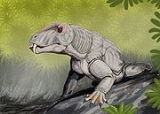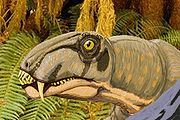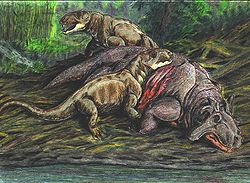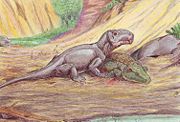
Brithopodidae
Encyclopedia
Brithopodidae are a paraphyletic family
of primitive mostly carnivorous Dinocephalia
ns known from the Middle Permian
of Russia. Nowadays the name is used less often, being replaced by Anteosaur
ia (a generic name for the clade
that includes the carnivorous branch of dinocephalia (Hopson & Barghusen 1986, Rubidge & Sidor 2001).
The original Dinosaurus, named by Johann Fischer von Waldheim
in 1845, was probably a specimen of the genus Brithopus
.
and Eotitanosuchidae (Biarmosuchus
and Eotitanosuchus
) ( Chudinov, 1965 p. 120). The skull of some Brithopodids closely resemble those of the early Biarmosuchia
. The South African paleontologist Lieuwe Dirk Boonstra
pointed out the great similarity between the skull of Syodon
and that of Eotitanosuchus
(Boonstra 1963 p. 199).
Although the limbs are more upright, the postcranial skeleton retains the general form of the sphenacodont
pelycosaur
s. (Carroll 1988 p. 371).
However, the temporal opening is greatly enlarged, indicated more space for jaw muscles and hence a much stronger bite. There are also sharp crests near the midline of the skull for attachment of jaw muscles. The canines
are long, with cheek teeth adapted to piercing, and the incisor
s are also large and pointed, and intermesh when closed all of which indicates a carnivorous
diet, and teeth adapted to cutting flesh from their prey (Carroll ibid).
 The family was erected by Efremov in 1954 to include a number of large carnivorous therapsids found in the Copper Sandstones and other Cis-Uralian localities, including the Cis-Uralian Deinocephalian Complexes and the Isheevian Deinocephalian Complex (Olsen 1962 p. 57).
The family was erected by Efremov in 1954 to include a number of large carnivorous therapsids found in the Copper Sandstones and other Cis-Uralian localities, including the Cis-Uralian Deinocephalian Complexes and the Isheevian Deinocephalian Complex (Olsen 1962 p. 57).
Olsen included the Brithopodidae with the Phthinosuchidae and Biarmosuchidae
in the larger category "Eotheriodontia". He did not consider the Brithopodids related to herbivorous Dinocephalia (Tapinocephalia
) but saw them as related to the Gorgonopsia
and other Theriodont
s. His theory is not longer followed by current workers in this field.
Boonstra
retained most of the Russian genera (along with Deuterosaurus) in the Brithopodidae, but transferred several genera to the Anteosauridae
, the family based on Anteosaurus
, which he erected at the same time. However he considered the two groups closely related, the Brithopodidae differing from the Anteosauridae by being somewhat more primitive.
Hopson and Barghusen, in the first cladistic
study of the Therapsida, coined the term Anteosauria, and synonymised the families Brithopodidae and Anteosauridae. Their "Anteosaurini" is probably equivalent to Boonstra's "Anteosauridae", in that both include Anteosaurus and Doliosaurus/Doliosauriscus. (see Hopson & Barghusen 1986 p. 91 and Boonstra 1969 pp,59-60)
King
1988 downgraded the Brithopodids to subfamily status (Brithopodinae).
In 1994, Ivakhnenko transferred several Brithopodid genera to the family Syodontidae
.

 A number of other forms have been discovered since, in South Africa (Australosyodon
A number of other forms have been discovered since, in South Africa (Australosyodon
) and China (Stenocybus
, Sinophoneus). However with the cladistic revolution, the name "Brithopodidae" is now falling out of fashion in favour of "Anteosaur
ia", and so they are generally not included in the family.
Family (biology)
In biological classification, family is* a taxonomic rank. Other well-known ranks are life, domain, kingdom, phylum, class, order, genus, and species, with family fitting between order and genus. As for the other well-known ranks, there is the option of an immediately lower rank, indicated by the...
of primitive mostly carnivorous Dinocephalia
Dinocephalia
Dinocephalia are a clade of large early therapsids that flourished during the Middle Permian, but became extinct leaving no descendants.-Description:...
ns known from the Middle Permian
Permian
The PermianThe term "Permian" was introduced into geology in 1841 by Sir Sir R. I. Murchison, president of the Geological Society of London, who identified typical strata in extensive Russian explorations undertaken with Edouard de Verneuil; Murchison asserted in 1841 that he named his "Permian...
of Russia. Nowadays the name is used less often, being replaced by Anteosaur
Anteosaur
Anteosaurs are a group of large, primitive carnivorous Dinocephalians , with huge canines and incisors and short limbs, that are known from the Middle Permian of South Africa, Russia, and China. The largest grew to very large size, with skulls 50 to 80 cm long, and were the largest predators...
ia (a generic name for the clade
Clade
A clade is a group consisting of a species and all its descendants. In the terms of biological systematics, a clade is a single "branch" on the "tree of life". The idea that such a "natural group" of organisms should be grouped together and given a taxonomic name is central to biological...
that includes the carnivorous branch of dinocephalia (Hopson & Barghusen 1986, Rubidge & Sidor 2001).
The original Dinosaurus, named by Johann Fischer von Waldheim
Johann Fischer von Waldheim
Johann Gotthelf Fischer von Waldheim was a German anatomist, entomologist and paleontologist....
in 1845, was probably a specimen of the genus Brithopus
Brithopus
Brithopus is an extinct genus of dinocephalian therapsid.-Dinosaurus:Dinosaurus, a junior synonym of Brithopus, was first described in 1845 by Johann Fischer von Waldheim, first as a species of Rhopalodon Brithopus is an extinct genus of dinocephalian therapsid.-Dinosaurus:Dinosaurus, a junior...
.
Characteristics
The Brithopodids are very primitive Eutheraspids, not far removed from ancestral synapsids. The Russian paleontologist Peter Chudinov noted that the Ocher brithopidids are similar to but slightly more advanced then the contemporary or slightly later PhthinosuchidaePhthinosuchus
Phthinosuchus was a therapsid that lived in the Late Permian of Russia. Phthinosuchus is the sole member of its family and suborder, although Phthinosaurus may be a relative...
and Eotitanosuchidae (Biarmosuchus
Biarmosuchus
Biarmosuchus tener was a therapsid that lived around 255 mya during the late Permian period. It was discovered in the Perm region of Russia. The specimen was found in channel sandstone that was deposited by flood waters originating from the young Ural mountains. The species is the most primitive of...
and Eotitanosuchus
Eotitanosuchus
Eotitanosuchus olsoni is a mammal-like reptile whose fossils were found in the town of Ochyor in Perm Krai, Russia, in channel flood deposits along with Biarmosuchus tener, Estemmenosuchus uralensis and Estemmenosuchus mirabilis.It lived about 255 mya and was a very large animal; although the...
) ( Chudinov, 1965 p. 120). The skull of some Brithopodids closely resemble those of the early Biarmosuchia
Biarmosuchia
Biarmosuchia, also known as Eotitanosuchia and Phthinosuchia, is an assemblage of primitive Permian therapsids that represent either a paraphyletic stem group or a very early off-shoot of the main therapsid tree....
. The South African paleontologist Lieuwe Dirk Boonstra
Lieuwe Dirk Boonstra
Lieuwe Dirk Boonstra was a South African paleontologist whose work focused on the mammal-like reptiles of the Middle and Late Permian, whose fossil remains are common in the South African Karroo...
pointed out the great similarity between the skull of Syodon
Syodon
Syodon is an extinct genus of dinocephalian therapsid....
and that of Eotitanosuchus
Eotitanosuchus
Eotitanosuchus olsoni is a mammal-like reptile whose fossils were found in the town of Ochyor in Perm Krai, Russia, in channel flood deposits along with Biarmosuchus tener, Estemmenosuchus uralensis and Estemmenosuchus mirabilis.It lived about 255 mya and was a very large animal; although the...
(Boonstra 1963 p. 199).
Although the limbs are more upright, the postcranial skeleton retains the general form of the sphenacodont
Sphenacodontidae
Sphenacodontidae is a family of small to large, advanced, carnivorous, Late Pennsylvanian to middle Permian pelycosaurs. Primitive forms were generally small in size , but during the later part of the early Permian these animals grew progressively larger , to become the top predators of their...
pelycosaur
Pelycosaur
The pelycosaurs are an informal grouping composed of basal or primitive Late Paleozoic synapsid amniotes. Some species were quite large and could grow up to 3 meters or more, although most species were much smaller...
s. (Carroll 1988 p. 371).
However, the temporal opening is greatly enlarged, indicated more space for jaw muscles and hence a much stronger bite. There are also sharp crests near the midline of the skull for attachment of jaw muscles. The canines
Canine tooth
In mammalian oral anatomy, the canine teeth, also called cuspids, dogteeth, fangs, or eye teeth, are relatively long, pointed teeth...
are long, with cheek teeth adapted to piercing, and the incisor
Incisor
Incisors are the first kind of tooth in heterodont mammals. They are located in the premaxilla above and mandible below.-Function:...
s are also large and pointed, and intermesh when closed all of which indicates a carnivorous
Carnivore
A carnivore meaning 'meat eater' is an organism that derives its energy and nutrient requirements from a diet consisting mainly or exclusively of animal tissue, whether through predation or scavenging...
diet, and teeth adapted to cutting flesh from their prey (Carroll ibid).
Taxonomic history

Olsen included the Brithopodidae with the Phthinosuchidae and Biarmosuchidae
Biarmosuchus
Biarmosuchus tener was a therapsid that lived around 255 mya during the late Permian period. It was discovered in the Perm region of Russia. The specimen was found in channel sandstone that was deposited by flood waters originating from the young Ural mountains. The species is the most primitive of...
in the larger category "Eotheriodontia". He did not consider the Brithopodids related to herbivorous Dinocephalia (Tapinocephalia
Tapinocephalia
The tapinocephalians are one of the major groups of dinocephalian therapsids. Unlike anteosaurs and estemmenosuchids, tapinocephalians are mainly from Africa and only one species is found in the north - Ulemosaurus from Russia. The tapinocephalians are divided into three clades, Styracocephalidae,...
) but saw them as related to the Gorgonopsia
Gorgonopsia
Gorgonopsia is a suborder of therapsid synapsids. Their name is a reference to the Gorgons of Greek mythology. Like other therapsids, gorgonopsians were at one time called "mammal-like reptiles"...
and other Theriodont
Theriodont
Theriodonts , are a major group of therapsids. They can be defined in traditional, Linnaean terms, in which case they are a suborder of mammal-like reptiles that lived from the Middle Permian to the Middle Cretaceous, or in Cladistic terms, in which case they include not only the traditional...
s. His theory is not longer followed by current workers in this field.
Boonstra
Lieuwe Dirk Boonstra
Lieuwe Dirk Boonstra was a South African paleontologist whose work focused on the mammal-like reptiles of the Middle and Late Permian, whose fossil remains are common in the South African Karroo...
retained most of the Russian genera (along with Deuterosaurus) in the Brithopodidae, but transferred several genera to the Anteosauridae
Anteosauridae
The Anteosauridae or Anteosaurinae are a family or subfamily of very large carnivorous Dinocephalia that are known from the Middle Permian of Russia and South Africa...
, the family based on Anteosaurus
Anteosaurus
Anteosaurus is the name given to an extinct genus of large carnivorous synapsid. It lived during the Capitanian epoch of the Middle Permian in what is now South Africa...
, which he erected at the same time. However he considered the two groups closely related, the Brithopodidae differing from the Anteosauridae by being somewhat more primitive.
Hopson and Barghusen, in the first cladistic
Cladistics
Cladistics is a method of classifying species of organisms into groups called clades, which consist of an ancestor organism and all its descendants . For example, birds, dinosaurs, crocodiles, and all descendants of their most recent common ancestor form a clade...
study of the Therapsida, coined the term Anteosauria, and synonymised the families Brithopodidae and Anteosauridae. Their "Anteosaurini" is probably equivalent to Boonstra's "Anteosauridae", in that both include Anteosaurus and Doliosaurus/Doliosauriscus. (see Hopson & Barghusen 1986 p. 91 and Boonstra 1969 pp,59-60)
King
Gillian King
Gillian King has worked in teaching and research in paleontology, as Assistant Curator at the Zoological Collections at Oxford University Museum, and a Fellow and Tutor as St Hilda's College, Oxford. She spent 15 years at Oxford and five years at the South African Museum in Cape Town, where she...
1988 downgraded the Brithopodids to subfamily status (Brithopodinae).
In 1994, Ivakhnenko transferred several Brithopodid genera to the family Syodontidae
Syodontidae
Syodontidae are a possibly paraphyletic family of smallish primitive carnivorous Dinocephalia. They lack the distinctive 'boss' on the lower jaw, that characterises the Anteosauridae, so they can be considered more primitive. They are known from the Middle Permian Period of what is now Russia...
.
Included genera
The following genera have been or are included in the family:
- AdmetophoneusAdmetophoneusAdmetophoneus is an extinct genus of non-mammalian synapsid.-References:*...
is included in the AnteosauridaeAnteosauridaeThe Anteosauridae or Anteosaurinae are a family or subfamily of very large carnivorous Dinocephalia that are known from the Middle Permian of Russia and South Africa...
by Boonstra 1969 - ArchaeosyodonArchaeosyodonArchaeosyodon is an extinct genus of dinocephalian therapsid....
may be a TitanosuchidTitanosuchidaeThe titanosuchids were carnivorous to omnivorous tapinocephalid dinocephalians. As with other tapinocephalids, they had thick-skulls probably for head-butting. They appeared in the Middle Permian. They had large canine teeth, and their incisors were very strong... - BrithopusBrithopusBrithopus is an extinct genus of dinocephalian therapsid.-Dinosaurus:Dinosaurus, a junior synonym of Brithopus, was first described in 1845 by Johann Fischer von Waldheim, first as a species of Rhopalodon Brithopus is an extinct genus of dinocephalian therapsid.-Dinosaurus:Dinosaurus, a junior...
- ChthomaloporusChthomaloporusChthomaloporus is an extinct genus of Anteosaurian synapsid.-References:*...
- DeuterosaurusDeuterosaurusDeuterosaurus is a genus of the Therapsids, one of the "mammal-like” reptiles dominating land during the late Palaeozoic.-Anatomy:Skulls of Deuterosaurus are well-known from several finds. They were around 80 cm with a long snout and conical teeth. Like all anteosaurs, the skull possessed long,...
is a herbivorousHerbivoreHerbivores are organisms that are anatomically and physiologically adapted to eat plant-based foods. Herbivory is a form of consumption in which an organism principally eats autotrophs such as plants, algae and photosynthesizing bacteria. More generally, organisms that feed on autotrophs in...
genus that is sometimes placed in its own family. - DoliosauriscusDoliosauriscusDoliosauriscus is an extinct genus of dinocephalian therapsid that lived in Russia during the mid-Permian Period. It was a large carnivore, its skull measuring 53 centimeters long.thumb|left|200px...
(originally Doliosaurus) is included in Anteosauridae sensu Boonstra 1969 and the Anteosaurini sensu Hopson & Barghusen 1986. It is considered closely related to AnteosaurusAnteosaurusAnteosaurus is the name given to an extinct genus of large carnivorous synapsid. It lived during the Capitanian epoch of the Middle Permian in what is now South Africa... - EosyodonEosyodonEosyodon is an extinct genus of non-mammalian synapsid.-References:*...
is an American genus that was added by Everett Olson but is now known to be a chimeraChimera (paleontology)In paleontology, a chimera is a fossil which was reconstructed with elements coming from more than a single species of animal. A now classic example of chimera is Protoavis.-List of paleontological chimeras:*Brontosaurus*Lametasaurus...
. - MnemeiosaurusMnemeiosaurusMnemeiosaurus is an extinct genus of Dinocephalian synapsid.-References:*...
- NotosyodonNotosyodonNotosyodon is an extinct genus of non-mammalian synapsid.-References:*...
is probably included under the SyodontidaeSyodontidaeSyodontidae are a possibly paraphyletic family of smallish primitive carnivorous Dinocephalia. They lack the distinctive 'boss' on the lower jaw, that characterises the Anteosauridae, so they can be considered more primitive. They are known from the Middle Permian Period of what is now Russia...
of Ivakhnenko 1994 - SyodonSyodonSyodon is an extinct genus of dinocephalian therapsid....
is probably included under the SyodontidaeSyodontidaeSyodontidae are a possibly paraphyletic family of smallish primitive carnivorous Dinocephalia. They lack the distinctive 'boss' on the lower jaw, that characterises the Anteosauridae, so they can be considered more primitive. They are known from the Middle Permian Period of what is now Russia...
of Ivakhnenko 1994 - TitanophoneusTitanophoneusTitanophoneus potens was a carnivorous Therapsid of the Dinocephalia group related to the Estemmenosuchidae, but living 5 million years later than Estemmenosuchus, during the Late Permian. Remains of this animal have been found at Isheevo in RussiaAn adult skull would have reached 80 cm with a...
is listed as Brithopodid by Carroll 1988, and Anteosaurinae by Hopson & Barghusen 1986.

Australosyodon
Australosyodon is an extinct genus of dinocephalian therapsid.-References:*...
) and China (Stenocybus
Stenocybus
Stenocybus is an extinct genus of dinocephalian therapsid....
, Sinophoneus). However with the cladistic revolution, the name "Brithopodidae" is now falling out of fashion in favour of "Anteosaur
Anteosaur
Anteosaurs are a group of large, primitive carnivorous Dinocephalians , with huge canines and incisors and short limbs, that are known from the Middle Permian of South Africa, Russia, and China. The largest grew to very large size, with skulls 50 to 80 cm long, and were the largest predators...
ia", and so they are generally not included in the family.
Links
- Palaeos - detailed description
- Mikko's Phylogeny Archive - list of genera in the form of a cladogramCladogramA cladogram is a diagram used in cladistics which shows ancestral relations between organisms, to represent the evolutionary tree of life. Although traditionally such cladograms were generated largely on the basis of morphological characters, DNA and RNA sequencing data and computational...

